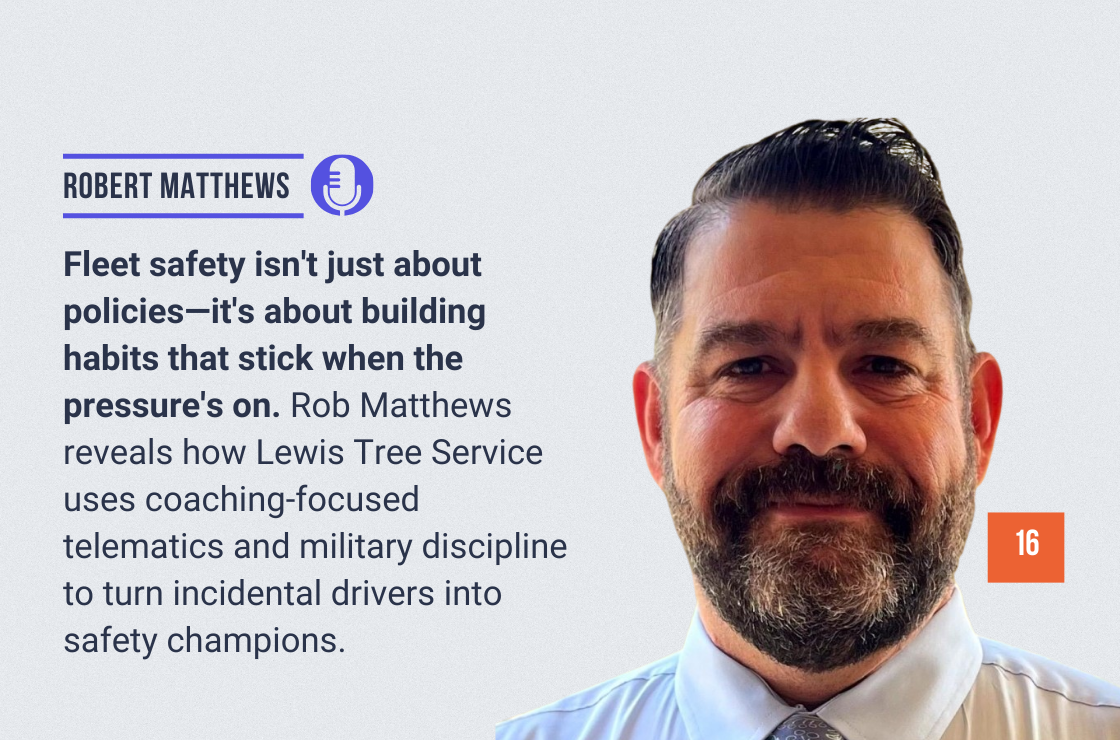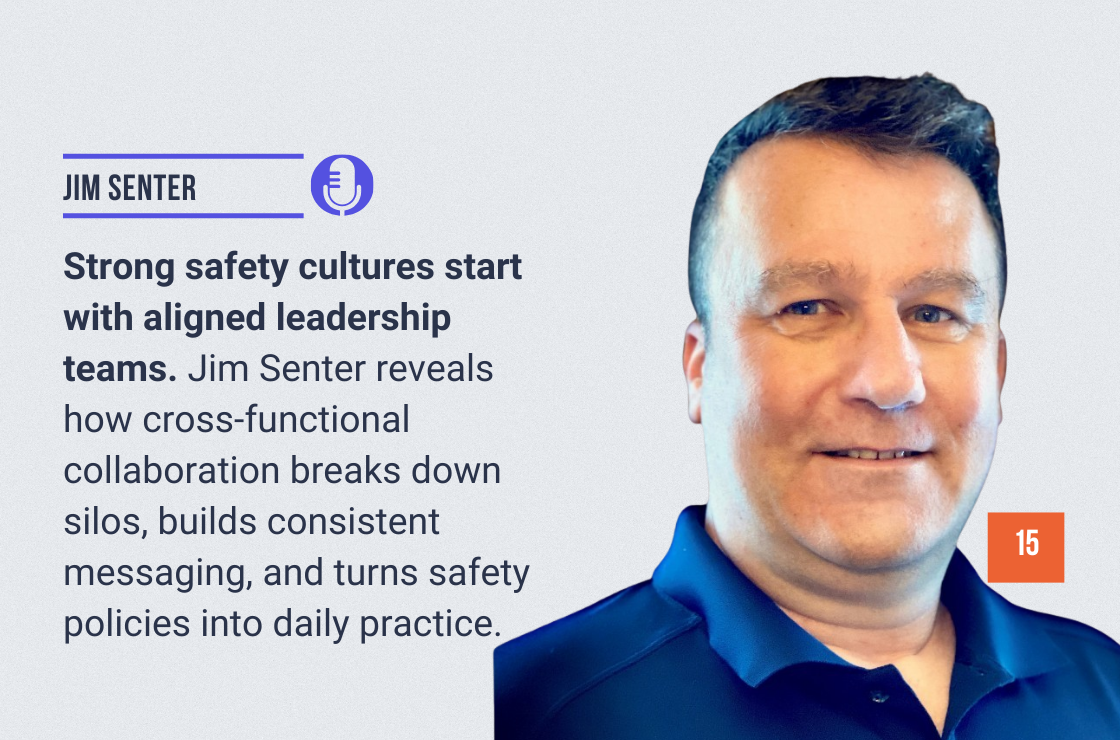
Rob Matthews currently serves as Regional Fleet Manager at Lewis Tree Service, a 100% employee-owned company where he oversees critical operations across a diverse fleet of commercial and utility vehicles. A Marine Corps veteran with over 27 years of hands-on experience, Rob has built an impressive track record managing light, medium, and heavy-duty fleets across industries including waste management, propane distribution, and military logistics. His approach is rooted in operational excellence, data-driven decision making, and a relentless focus on safety, compliance, and process improvement. From multiple deployments in Iraq and Afghanistan to executing fleet strategy back home, Rob brings discipline, accountability, and mentorship to the forefront of everything he does.
Here’s a glimpse of what you’ll learn:
- [02:43] Rob’s journey from Hot Wheels in the sandbox to managing real bucket trucks
- [04:23] The unique challenge of “incidental drivers” who are craft workers first, drivers second
- [06:28] How Lewis Tree Service keeps America’s power lines clear while managing 26,000-pound vehicles
- [08:39] The two-method approach: being present with drivers and using coaching-focused technology
- [10:46] Why driver-facing cameras became a game-changer for behavior modification and coaching
- [13:25] Real-world exoneration stories: how video evidence protects drivers and resolves disputes
- [15:30] Tracking safe driving habits instead of just measuring crashes and incidents
- [18:07] The power of positive reinforcement: celebrating good behaviors caught on camera
- [19:10] “Complacency kills” – bringing military mindset to civilian fleet safety culture
- [21:11] Supply chain challenges and the importance of backup plans in fleet management
- [26:30] Why humility and continuous learning are essential for fleet managers
- [31:09] Lightning round: theme songs, futuristic features, and the hot dog sandwich debate
In this episode…
When your drivers are craft workers first and professional drivers second, how do you instill the discipline needed to safely operate 26,000-pound bucket trucks through residential neighborhoods? The challenge becomes even more complex when these same drivers are responsible for keeping America’s lights on, often working in high-pressure storm response situations where lives and communities depend on their expertise.
According to Rob Matthews, Regional Fleet Manager at Lewis Tree Service, the answer lies in combining military leadership principles with smart technology deployment. Drawing from his Marine Corps experience and 27 years in fleet operations, Rob explains how his team transformed their safety culture by focusing on coaching rather than punishment, using driver-facing cameras as development tools, and maintaining the “complacency kills” mindset that keeps standards high even when operations run smoothly.
In this episode of RoadRageous, host Chad Lindholm sits down with Rob to explore how military discipline translates to civilian fleet management. They discuss the unique challenges of managing incidental drivers, the power of positive reinforcement in safety programs, and why building authentic relationships with frontline workers is just as important as implementing the latest technology.
Quotable Moments:
- “I’ve been doing fleet my entire life. From Hot Wheels in the sandbox to bucket trucks.”
- “Our drivers have a unique responsibility to be a professional driver, but they have an additional responsibility—and that’s a primary responsibility—to be a craft worker and keep the power lines clear.”
- “You have to be present. You have to be in front of the work groups. You have to reinforce it, because they have a lot coming in, so some of it gets forgotten.”
- “If the coaching is not a gotcha, if it’s ‘this is here to help,’ and we’re relying on technology so that we can be better at what we’re doing collectively as an organization.”
- “Complacency kills. Don’t be complacent. Don’t accept the status quo. Always be alert, always be vigilant.”
- “A safety culture is not necessarily just a program. It should be infectious. You should want to be safe.”
- “Be humble. You don’t know everything and never stop learning.”
- “I think of myself more as a thought collector. I want to hear what other people’s ideas are.”
Action Steps:
- Be physically present with your drivers: You can’t manage safety through emails alone—get in front of work groups and reinforce training consistently
- Use technology for coaching, not punishment: Frame driver-facing cameras and telematics as tools for improvement, not surveillance
- Track leading indicators over lagging ones: Focus on safe driving habits (following distance, hard braking, speeding) rather than just crash statistics
- Celebrate positive behaviors: Use technology to identify and reward good driving habits, not just correct bad ones
- Apply “complacency kills” mindset: Maintain safety standards consistently, even when operations are running smoothly
- Connect safety to cost savings: Show drivers how safe driving reduces fuel costs, tire wear, and maintenance expenses
- Develop backup plans for supply chain challenges: Build relationships with vendors and have alternative sourcing strategies ready
- Stay humble and keep learning: Technology evolves rapidly in fleet management—remain open to new ideas and perspectives
Military Precision Meets Fleet Management Innovation
In a recent episode of RoadRageous, host Chad Lindholm welcomed Rob Matthews, Regional Fleet Manager at Lewis Tree Service, to discuss how military leadership principles can transform civilian fleet safety programs. The conversation centered on managing the unique challenges of “incidental drivers”—skilled craft workers who must also operate large commercial vehicles as part of their primary job duties.
The Challenge of Dual-Role Drivers
Rob explained the complex reality facing Lewis Tree Service drivers: they’re primarily skilled tradespeople responsible for vegetation management and power line clearance, but they must also safely operate 26,000-pound bucket trucks through residential areas. This dual responsibility creates unique training and safety challenges, as driving becomes secondary to their primary craft work despite the significant safety implications.
Key Discussion Points:
- Military-Inspired Safety Culture: Rob applies the “complacency kills” mindset from his military deployments to civilian fleet operations, emphasizing that safety standards must be maintained consistently regardless of how routine operations become.
- Technology as a Coaching Tool: The implementation of driver-facing cameras at Lewis Tree Service focuses on development rather than punishment, with frontline leaders using video footage to provide constructive feedback and reinforce positive behaviors.
- Present Leadership Approach: Rob emphasizes the importance of physical presence with drivers, noting that safety messages can’t be effectively communicated through emails alone—leaders must be in front of work groups to reinforce training.
- Positive Behavior Recognition: The telematics system at Lewis Tree Service is sophisticated enough to identify and reward safe driving behaviors, allowing managers to celebrate good decisions caught on camera rather than only addressing violations.
- Leading vs. Lagging Indicators: Rather than focusing solely on crash statistics, the organization tracks safe driving habits like following distance, hard braking, and speed management to prevent incidents before they occur.
- Real-World Exoneration: Rob shared multiple examples of how video evidence has protected drivers from false citations and provided law enforcement with actionable data during incident investigations.
Supply Chain Resilience and Innovation
The episode also addressed current fleet management challenges including supply chain disruptions, rising costs, and parts availability. Rob emphasized the importance of building strong vendor relationships, developing backup plans, and connecting safety initiatives to cost savings through improved fuel efficiency and reduced maintenance needs.
Conclusion:
Rob’s insights demonstrate that effective fleet safety management requires more than just implementing technology—it demands authentic leadership, consistent presence, and a culture that values continuous improvement. By combining military discipline with modern fleet management tools, organizations can create safety programs that protect both drivers and the communities they serve while maintaining operational efficiency in challenging environments.
Resources mentioned in this episode:
- Rob Matthews on LinkedIn
- Lewis Tree Service
- Motive Fleet Management Platform
- Chad Lindholm on LinkedIn
- IMPROVLearning
- Previous episode with Jim Davis on AI video technology
- Previous episode with Mike on stress reduction through safer driving
Sponsor for this episode:
This episode is brought to you by IMPROVLearning.
At IMPROVLearning, we’re dedicated to transforming driver education through innovative, research-backed training methods.
Our SPIDER™ Driver Training platform combines humor with proven brain-training techniques to help drivers anticipate and avoid potential dangers on the road.
With over four million students trained, we know that learning sticks best when it’s engaging, short, and actively tested — resulting in fewer crashes, violations, and safer drivers overall.
To learn more about how IMPROVLearning makes roads safer one driver at a time, visit improvlearning.com.







